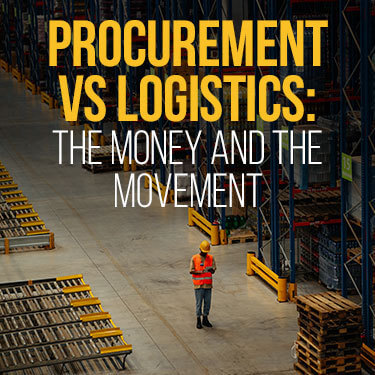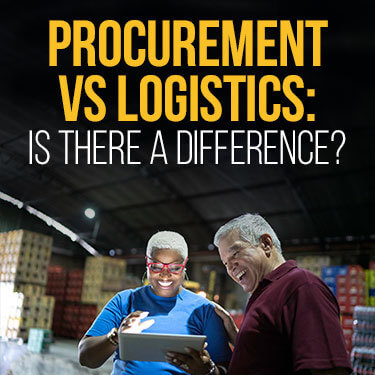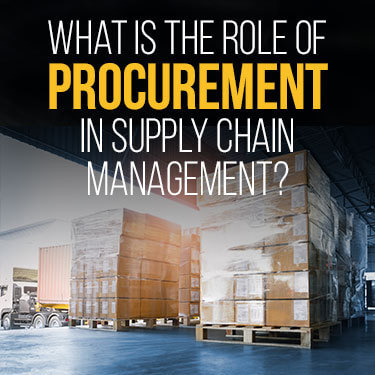
 Copy URL to Clipboard
Copy URL to Clipboard
A full breakdown of procurement vs logistics would reveal a great number of common elements. For some organizations, a procurement team and a logistics team are one and the same. In others, they’re related partners that rely on each other’s skills and services. It’s important to understand the relationship between procurement and logistics in supply chain.
Procurement is the practice of finding vendors, securing raw materials, and arranging purchases. The goal is to make sure a company has everything it needs to produce and distribute a product long-term. Logistics covers the processes that make it possible to transport, store, manufacture, and distribute the final products.
Gain an understanding of these practices and how they work within a supply management system.
Table of Contents
To figure out procurement and logistics, you need to know how they overlap and why. Logistics is often a general term for anything involving product movement, including purchasing.
Since logistics is so broad, more vocabulary has developed to better define specific aspects. For example, most businesses will distinguish between inbound logistics and outbound logistics. This is because they affect different parts of a business.
The best way to identify procurement is to look at which distinct processes are often involved.
A procurement specialist works in
For a single procurement specialist or team, that’s quite a bit. The bigger the company, the more complex procurement and sourcing are. Saying that procurement is only the process of acquiring goods is a gross understatement.
Smaller companies that are trying to expand are likely to have employees that perform more than one duty. Someone in charge of procurement might be responsible for arranging transportation and storage. These are responsibilities that fall more under a logistics management umbrella.
This doesn’t change the fact that procurement and logistics are two separate activities.

The term procurement logistics sometimes gets tossed around too. We’ve already established that they are separate activities. Why the term then?
The term procurement logistics places sourcing and purchasing within the greater category of supply chain management.
In simple terms though, procurement is only a part of a greater logistics whole, specifically inbound logistics.
The logistics team working with procurement services handles
Some of the above responsibilities might be considered part of outbound logistics. That is the part of the business that connects directly with customers. Either way, the focus is on the physical movement of goods and services.
When you compare the responsibilities, the differences between procurement and logistics become clear. Each specialty comes with unique challenges.

Supply chain management doesn’t exist unless there are actual supplies - hence the name. Procurement makes supply chain management possible.
Whether your company is offering physical goods or some form of digital service, supplies play a part. When a procurement manager is doing the job right, supply chain management knows what supplies are available or still needed.
Supply chain management tries to balance supply, production, and demand. Too little or too much in any of those areas is bad for business.
This makes communication between each area important. When demand for a product starts going down, it makes sense to ease up purchasing the raw materials needed for it. If that information isn’t communicated, you might end up with a warehouse full of obsolete merchandise.
Supply chain managers are in place to ensure that communication happens. Having the big picture in mind, they can use strategies in each sector to improve overall company performance.
This would include
Even though procurement is only a part of the bigger picture, it doesn’t make it any less necessary.
Procurement and logistics can still work independently to improve processes to serve a company as a whole. Departments can streamline their actions and make it easier to study the big picture. .
What is that like on the procurement side? It’s about finding ways to work smarter and use the best resources.
Best practices in procurement include:
Finding supplies and materials is challenging. Many companies are learning the hard way that single-supply sourcing can fall apart easily. Even when supplies are found, a lack of logistical support makes it impossible to get them anywhere.
A procurement team needs to think creatively and more globally than ever before. Clear communication, good training practices, and standard policies help keep things on track.
There are some areas in procurement that still benefit from a little bit of specialized attention though.

Whether your company operates on a global or domestic scale, planning for disruption has taken on new meaning.
Some disasters, like the Covid-19 pandemic, came out of nowhere and there really was no planning for it. It is possible to prepare for other types of natural disasters to an extent, even abrupt ones like earthquakes. The same goes for cyberattacks and even political unrest.
A team working on supply knows how quickly it can be disrupted and what is likely to do so.
These events, and many like them, continue to disrupt a global supply chain still attempting to recover from Covid-19 effects. The increased frequency has procurement teams figuring out creative solutions.
Emergency procedure plans, as mentioned before, can help manage disruptions so that you don’t lose valued customers.
When clients see purposeful actions from companies after a disaster, it sends a good message. You can’t control when a disruption to your supply chain will happen, but you can control how your company reacts.
If your procurement team works with raw materials, you know that some are easier to get than others. Sometimes, it isn’t about how common it is, but how much demand exists.
Shortages in raw and base materials affect output in other industries, too. One study showed that 89% of procurement managers said they were short on raw materials. The industry breakdown is below and shows how some have been more impacted than others.
| Manufacturing | 49% |
| Mechanical Engineering | 16% |
| Automotive | 11% |
When shortages are high, prices go up. According to the same study, most companies end up passing those costs along to consumers. In turn, they lose consumers because of higher pricing. It becomes a challenging cycle that procurement teams need to manage carefully.
Getting the best deals possible on what raw materials are available has an impact on final product pricing and selling. Procurement specialists using demand planning can help.
It does mean keeping an eye not just on market demand, but supplier behaviors. Supply and demand is easily impacted by world events. Predicting outcomes is possible with study long-term experience.
The battle for better procurement and logistics services is more intense than ever. As prices of materials and shipping rise, you need a support team that knows how to call the shots.
Fulfillment and Distribution Services, powered by R+L Global Logistics, has decades of experience. It also has the reach to make it work for you. With warehouses all around the country, we can store, cross dock, or transload your supplies almost everywhere.
Call us today at (866) 989-3082 to speak with one of our fulfillment specialists directly. If you need answers fast, request an online services quote today. Better supply chain management is within your reach.
